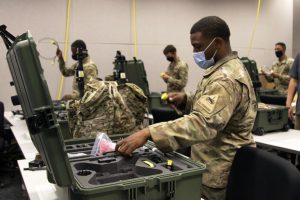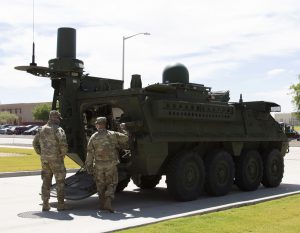
Fort Bliss, Texas – An Electronic Warfare Specialist in 1st Armored Division inventories assets for the VMAX dismounted Electronic Warfare system. 1AD is the first division in III Corps to overhaul its EW capabilities as a part of the Army’s campaign to modernize its force for 21st-century conflict. (U.S. Army photo by Jean S. Han) (Jean Han)
FORT BLISS, Texas – Imagine dismantling enemy forces without having boots on the ground or firing a single shot. Imagine knowing who and where your enemy is, what they are saying, and what they are doing — without them ever hearing or seeing you.
It may seem like the impossible, but for America’s Tank Division, this will soon become their new reality, as they will be the first unit in the III Corps to overhaul their Electronic Warfare (EW) capabilities as a part of the Army’s campaign to modernize its force for 21st-century conflict.
EW, as defined by the Department of Defense (DOD), are military activities that use electromagnetic energy to control the electromagnetic spectrum (EMS) and attack an enemy. In today’s increasingly connected world, the virtual battlefield is quickly becoming the next frontier for war.
“EW is critical to the Army because the world is evolving from the traditional, conventional way of combat. A lot of our systems are digital systems. Just about everything relies on electronic signals,” said Chief Warrant Officer 3 Harold Steed, the 1st Armored Division Electronic Warfare Technician.
“This is true not only for our country, but for our allies and near-peer adversaries, so it is vital that we maintain robust EW capabilities to keep up with or stay ahead of the game.”
1AD plans to strengthen their EW capabilities via a double-pronged effort that includes fielding new electronic warfare equipment and organizing new electronic warfare-specific units.

Fort Bliss, Texas – 1st Armored Division Electronic Warfare specialist take a look at the Army’s newest EW system, the Stryker-mounted Tactical Electronic Warfare System (TEWS), an integrated platform. 1AD is the first division in III Corps to overhaul its EW capabilities as a part of the Army’s campaign to modernize its force for 21st-century conflict. (U.S. Army photo by Jean S. Han) (Jean Han)
Modernizing EW: Fielding New Equipment
According to Capt. Eric Ziders, the Electronic Warfare Officer for 3rd Brigade Combat Team, 1AD, analyzing data from the spectrum can yield a wealth of information for commanders to use for their movements on the battlefield, which boosts the force’s lethality and combat readiness.
The Army’s latest EW system, the Tactical Electronic Warfare System (TEWS), allows EW units to provide commanders on the ground with vital, real-time data to make informed split-second decisions.
“The new system actually allows us to give commanders at higher echelons the capabilities and tools to be able to plan and make decisions on the battlefield; which is information that they didn’t have before,” said Chief Warrant Officer 2 Rob Tarkington, an Electronic Warfare Technician in 3BCT. “Commanders can now fit electronic warfare into their scheme of maneuver and use it as a weapon system on the battlefield to achieve mission objectives.”
Mounted on a Stryker, TEWS is an integrated platform that allows for sensing, signals intelligence, electronic warfare and RF-enabled cyberattacks – making it a first step towards integrating electronic and cyber warfare.
“TEWS provides a streamlined process that will enable the brigade a more efficient and consolidated electronic warfare package, as opposed to using three distinct pieces of equipment or using one piece of equipment in two separate vehicles as we have done in the past,” said Ziders.
Modernizing EW: Organizing New Units
The other major prong in the Army’s modernization campaign is the organization of new units that combine cyber and EW operations into a new discipline called spectrum warfare.
At 1AD, this has resulted in the creation of a joint electronic warfare and signals intelligence platoon called Spectre platoon.
“Our brigade commander and our EWO set up a new concept where we’ve consolidated all the EW Soldiers and NCOs into the brigade’s Military Intelligence Company and then integrated them with the Signal Intelligence Soldiers that were already there to create a joint platoon,” said Tarkington.
To help field the new EW systems, the Army has adjusted its training and recruitment programs to allow new soldiers to enlist directly into the Electronic Warfare Specialist, 17E, military occupational specialty (MOS). Previously, only Soldiers E5 and above were allowed to transfer into the EW career field.
Electronic Warfare specialists advise and assist the commander on electronic warfare operations. This person makes use of electromagnetic and directed energy to control the electromagnetic spectrum (EMS) and defeat the enemy through planning, coordination, integration, and execution of electronic attack (EA), electronic protection (EP), and electronic support (ES).
Now for the first time in EW history, EW units will be receiving recruits that will have started their career in EW and 1AD is the first III Corps division to receive these Soldiers straight out of their Advanced Individual Training (AIT), according to Steed.
According to Steed, the EW field has come a long way since it first got off the ground in 2009.
“When I got to my first unit, the EW program was virtually non-existent; none of the commanders knew what it was. So we pretty much built everything from the ground up,” said Steed.
“Being a part of EW from when it first started and seeing how much it’s grown, honestly I feel a sense of pride. I have no doubt in my mind that EW will continue to transition into something even bigger and better.”
